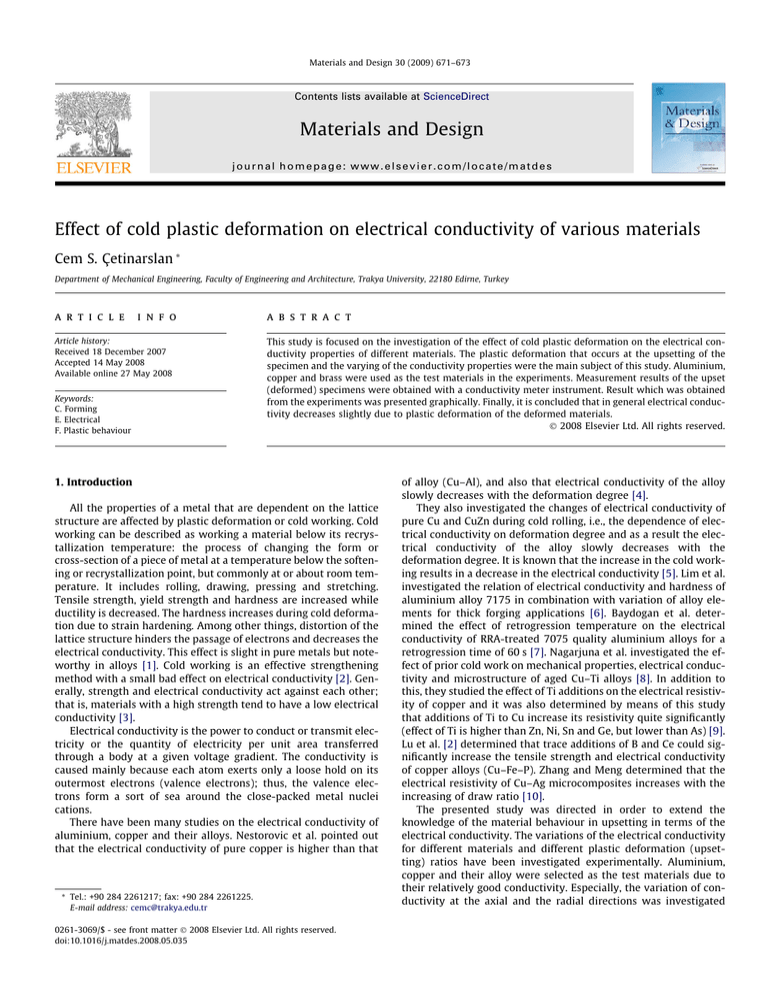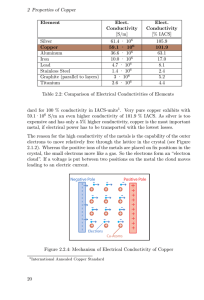
Materials and Design 30 (2009) 671–673
Contents lists available at ScienceDirect
Materials and Design
journal homepage: www.elsevier.com/locate/matdes
Effect of cold plastic deformation on electrical conductivity of various materials
Cem S. Çetinarslan *
Department of Mechanical Engineering, Faculty of Engineering and Architecture, Trakya University, 22180 Edirne, Turkey
a r t i c l e
i n f o
Article history:
Received 18 December 2007
Accepted 14 May 2008
Available online 27 May 2008
Keywords:
C. Forming
E. Electrical
F. Plastic behaviour
a b s t r a c t
This study is focused on the investigation of the effect of cold plastic deformation on the electrical conductivity properties of different materials. The plastic deformation that occurs at the upsetting of the
specimen and the varying of the conductivity properties were the main subject of this study. Aluminium,
copper and brass were used as the test materials in the experiments. Measurement results of the upset
(deformed) specimens were obtained with a conductivity meter instrument. Result which was obtained
from the experiments was presented graphically. Finally, it is concluded that in general electrical conductivity decreases slightly due to plastic deformation of the deformed materials.
Ó 2008 Elsevier Ltd. All rights reserved.
1. Introduction
All the properties of a metal that are dependent on the lattice
structure are affected by plastic deformation or cold working. Cold
working can be described as working a material below its recrystallization temperature: the process of changing the form or
cross-section of a piece of metal at a temperature below the softening or recrystallization point, but commonly at or about room temperature. It includes rolling, drawing, pressing and stretching.
Tensile strength, yield strength and hardness are increased while
ductility is decreased. The hardness increases during cold deformation due to strain hardening. Among other things, distortion of the
lattice structure hinders the passage of electrons and decreases the
electrical conductivity. This effect is slight in pure metals but noteworthy in alloys [1]. Cold working is an effective strengthening
method with a small bad effect on electrical conductivity [2]. Generally, strength and electrical conductivity act against each other;
that is, materials with a high strength tend to have a low electrical
conductivity [3].
Electrical conductivity is the power to conduct or transmit electricity or the quantity of electricity per unit area transferred
through a body at a given voltage gradient. The conductivity is
caused mainly because each atom exerts only a loose hold on its
outermost electrons (valence electrons); thus, the valence electrons form a sort of sea around the close-packed metal nuclei
cations.
There have been many studies on the electrical conductivity of
aluminium, copper and their alloys. Nestorovic et al. pointed out
that the electrical conductivity of pure copper is higher than that
* Tel.: +90 284 2261217; fax: +90 284 2261225.
E-mail address: cemc@trakya.edu.tr
0261-3069/$ - see front matter Ó 2008 Elsevier Ltd. All rights reserved.
doi:10.1016/j.matdes.2008.05.035
of alloy (Cu–Al), and also that electrical conductivity of the alloy
slowly decreases with the deformation degree [4].
They also investigated the changes of electrical conductivity of
pure Cu and CuZn during cold rolling, i.e., the dependence of electrical conductivity on deformation degree and as a result the electrical conductivity of the alloy slowly decreases with the
deformation degree. It is known that the increase in the cold working results in a decrease in the electrical conductivity [5]. Lim et al.
investigated the relation of electrical conductivity and hardness of
aluminium alloy 7175 in combination with variation of alloy elements for thick forging applications [6]. Baydogan et al. determined the effect of retrogression temperature on the electrical
conductivity of RRA-treated 7075 quality aluminium alloys for a
retrogression time of 60 s [7]. Nagarjuna et al. investigated the effect of prior cold work on mechanical properties, electrical conductivity and microstructure of aged Cu–Ti alloys [8]. In addition to
this, they studied the effect of Ti additions on the electrical resistivity of copper and it was also determined by means of this study
that additions of Ti to Cu increase its resistivity quite significantly
(effect of Ti is higher than Zn, Ni, Sn and Ge, but lower than As) [9].
Lu et al. [2] determined that trace additions of B and Ce could significantly increase the tensile strength and electrical conductivity
of copper alloys (Cu–Fe–P). Zhang and Meng determined that the
electrical resistivity of Cu–Ag microcomposites increases with the
increasing of draw ratio [10].
The presented study was directed in order to extend the
knowledge of the material behaviour in upsetting in terms of the
electrical conductivity. The variations of the electrical conductivity
for different materials and different plastic deformation (upsetting) ratios have been investigated experimentally. Aluminium,
copper and their alloy were selected as the test materials due to
their relatively good conductivity. Especially, the variation of conductivity at the axial and the radial directions was investigated
672
C. S. Çetinarslan / Materials and Design 30 (2009) 671–673
experimentally. Furthermore, it was observed that all the results
are in good agreement with the related literature [11].
2.3. Machining of upset (deformed) specimens for electrical
measurement
2. Experimental procedure
At this stage of the study, the cubic parts were machined
(milling) to 10 mm3 (10 10 10) from each upset specimens at
various deformation ratios. To measure each direction in the same
way, the specimen geometry was agreed upon as cubic. The
preparation process of the deformed cubic specimens is shown in
Fig. 2.
2.1. Definition of the testing materials and specimen geometry
In this study, aluminium 5083, two types of commercially pure
aluminium, commercially pure copper and CuZn40Pb2 brass were
used as the test materials. Firstly, cylindrical specimens were prepared. Specimens were machined (turned) to a diameter of 25 mm
and a height of 25 mm from all the materials.
35
34
33
axial
32
radial
31
30
0
10
20
30
40
50
60
Deformation Ratio(%)
Fig. 3. The effect of cold deformation ratio on the electrical conductivity of
aluminium 5083 upset specimens.
Commercial Aluminum (type 1)
Electrical
Conductivity(%IACS)
Experiments were carried out using flat faced dies and a
hydraulic press of 150 metric tons capacity with 5 mm/s ram
speed. Flat ended dies were machined from AISI H13 hot work tool
steel. Dies were oil quenched and tempered at 550 °C. Flat faces of
the dies were ground after heat treatment by using a grinding machine with a magnetic plate in order to obtain the final dimensions
and surface quality. Hardness values were measured as HRc =
52–54. The experimental set-up is shown in Fig. 1.
The cylindrical specimens were centred on the lower die and
were upset at different deformation ratios. Before the experiments,
the surfaces of dies and specimens were cleaned with pure alcohol
for each test. Specimens’ heights were measured and recorded before and after the tests. An electronic circuit stopped the vertical
movement of the upper die. Thus, experiments had ended at predetermined upsetting heights.
Electrical
Conductivity(%IACS)
Aluminum 5083
2.2. The upsetting tests
50.0
48.0
46.0
axial
44.0
radial
42.0
40.0
0
10
20
30
40
50
60
Deformation Ratio(%)
Electrical
Conductivity(%IACS)
Commercial Aluminum (type 2)
30.0
29.0
28.0
axial
27.0
radial
26.0
25.0
0
10
20
30
40
50
60
Deformation Ratio(%)
Fig. 1. Experimental set-up.
Fig. 4. The effect of cold deformation ratio on the electrical conductivity of two
types commercially (as purchased) aluminium upset specimens.
Fig. 2. Process sequence of the cubic conductivity specimens’ preparation.
C. S. Çetinarslan / Materials and Design 30 (2009) 671–673
Electrical
Conductivity(%IACS)
Commercial Copper
97.0
96.0
95.0
axial
94.0
radial
93.0
92.0
0
10
20
30
40
50
673
As it can be seen in Fig. 5 the conductivity values decrease
slowly with increasing deformation ratio for commercially pure
copper specimens.
Change of the electrical conductivity values with the increasing
deformation ratio for the brass specimens is seen in Fig. 6 and this
change is similar to that of copper specimens. Conductivity decreases slowly.
4. Conclusion
60
Deformation Ratio(%)
Fig. 5. The effect of cold deformation ratio on the electrical conductivity of
commercially pure copper upset specimens.
Electrical
Conductivity(%IACS)
Brass
25.0
24.5
24.0
axial
23.5
radial
23.0
22.5
22.0
0
10
20
30
Deformation Ratio(%)
Fig. 6. The effect of cold deformation ratio on the electrical conductivity of brass
upset specimens.
2.4. Electrical conductivity measurement
Electrical conductivity of the cubic specimens was measured,
using an electrical conductivity meter AutoSigma 3000 D as %IACS.
The SI derived unit for conductivity is Siemens per meter, but the
conductivity values are often reported as %IACS. Conductivity values in Siemens/meter can be converted to %IACS (International Annealed Copper Standard) by multiplying the conductivity value
with 1.7241 10 6. Each specimen was measured from both axial
and radial directions.
3. Results
Measurement procedure was completed according to the above
mentioned procedure. All the measurement test results are shown
in Figs. 3–6 for different materials and different deformation ratios.
Measurements were carried out at both axial direction (upsetting
direction) and radial direction (barreling direction).
Fig. 3 presents the electrical conductivity values for the upset
cubic Aluminium 5083 specimens. Values are close to each other
for almost all the deformation ratios. On an average, value of
32.5%IACS was obtained at the two directions.
Fig. 4 shows the change of electrical conductivity for the two
types of the commercially pure aluminium. The two types of aluminium were purchased from different sellers. It can be seen that
the electrical conductivity does not change clearly with increasing
deformation ratio but decreases a little after approximately %38
deformation ratio for type 1 (a) and type 2 (b). It can be said that
the average conductivity value of commercial aluminium is
45%IACS for type 1 and 28%IACS for type 2.
In this study, electrical conductivity of aluminium 5083, pure
aluminium, copper and brass has been examined. Evaluation of
the test results led to the following conclusions:
1. Though the electrical conductivity of pure copper is higher than
its alloy (brass), its conductivity decreases similarly with the
increasing deformation ratio. Brass specimens could not be
upset until high deformation rate because of their brittleness,
which is due to cold drawing.
2. It can be concluded that the electrical conductivity does not
change significantly with the increasing deformation ratio for
aluminium 5083 and commercial aluminium (it is possible that
the slight decrease in the commercial aluminium because of
their purity is only at the commercial level).
3. Conductivity values do not change significantly for all the tested
materials according to the measurement direction (axial or
radial).
4. Al-based materials are affected more slightly than Cu-based
materials from plastic deformation in terms of the electrical
conductivity. The effect of plastic deformation, that is strain
hardening on the electrical conductivity of aluminium and its
alloys is small, almost imperceptible.
5. This investigation can be extended using different cold working
methods (rolling, extrusion, etc.) and different materials.
Acknowledgement
The author would like to thank Dr. Murat Baydogan (Istanbul
Technical University) for his help in the measurement processes.
References
[1] Avner SH. Introduction to physical metallurgy. 2nd ed. McGraw-Hill; 1974.
[2] Lu D-P, Wang J, Zeng W-J, Liu Y, Lu L, Sun B-D. Study on high-strength and
high-conductivity Cu–Fe–P alloys. Mater Sci Eng A 2006;421:254–9.
[3] Ronto V, Nagy E, Sveda M, Tomolya F, Varga F, Molnar B. Developing materials
properties and electrical conductivity of Cu alloys by Jominy end-quench test.
Mater Sci Forum 2007;537–538:55–61.
[4] Nestorovic S, Markovic D, Ivanic L. Influence of degree of deformation in rolling
on anneal hardening effect of a cast copper alloy Bull. Mater. Sci. 2003;
26(6):601–4.
[5] Nestorovic S, Markovic D, Ivanic L. Influence of time of annealing on anneal
hardening effect of a cast CuZn alloy. J Min Met 2003;39:3–4B.
[6] Lim ST, Yun SJ, Nam SW. Improved quench sensitivity in modified aluminum
alloy 7175 for thick forging applications. Mater Sci Eng A 2004;371/1–2:
82–90.
[7] Baydogan M, Cimenoglu H, Kayali ES. A study on sliding wear of a 7075
aluminum alloy. Wear 2004;257:852–61.
[8] Nagarjuna S, Balasubramanian K, Sarma DS. Effect of prior cold work on
mechanical properties, electrical conductivity and microstructure of aged Cu–
Ti alloys. J Mater Sci 1999;34:2929–42.
[9] Nagarjuna S, Balasubramanian K, Sarma DS. Effect of Ti additions on the
electrical resistivity of copper. Mater Sci Eng A 1997;25:118–24.
[10] Zhang L, Meng L. Evolution of microstructure and electrical resistivity of Cu–
12 wt.%Ag filamentary microcomposite with drawing deformation. Scripta
Mater 2005:52;1187–1191.
[11] Smith WF. Principles of materials science and engineering [Turkish edition].
1st ed. Literatur Kitabevi; 2001.






